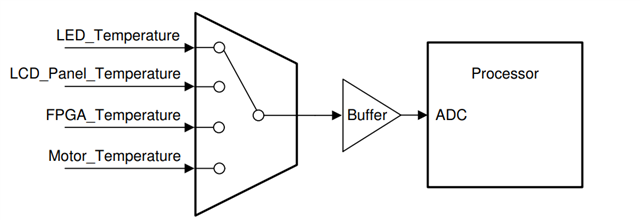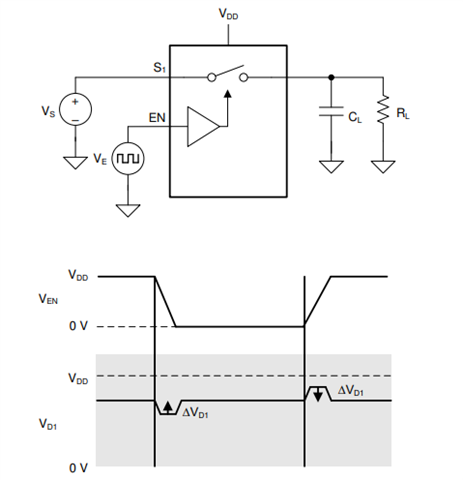Application Overview:
A very common, but very powerful use of a multiplexer is for applications in which there is a need for more GPIO pins for expanded functionality and utility. ADCs and MCUs are often resource constrained and a multiplexer can be a great way to help get the most out of these critical system components.

With designs of today needing more sensors and inputs to monitor a variety of systems, the available I/Os that are accompanied on ADCs and MCUs become increasingly limited. Multiplexers solve this problem by offering the capacity needed for such applications to be successful. In this FAQ, we will explore the benefits and design considerations of choosing to implement a multiplexer in such a scenario to expand the GPIOs of a given system.
Parameters of Interest:
There are several parameters that will need to be taken into consideration for choosing to design with a multiplexer for GPIO expansion.
Voltage Signal Range:
The first and most important will be the signal range compatibility between the sensors or inputs and the downstream ADC or MCU. Most MCUs will only need low voltage inputs (most likely <5V) while ADCs can require mid or even high voltage inputs to be sampled which can limit what multiplexers can be utilized in such an instance. Fortunately, TI offers a very wide array of multiplexers that can handle almost any operating signal range, just a matter of prioritizing a few key parameters specific to the application itself.
On-Resistance (RON)
In addition to the signal range, the on-resistance (RON) can play a pivotal role in how your application will behave. For precision applications that are often found when utilizing and ADC, RON can contribute an offset error in processing that would need to be accounted for. However, there are precision multiplexers in TI’s portfolio that offer extremely low RON that can make the multiplexer seem essentially invisible to the system.
On-Capacitance (CON)
CON is another component of the multiplexer that can be a critical parameter in an application as well. On-Capacitance is the main parameter that determines how fast the input can propagate to the output, the fall and rise times, bandwidth, and other timing parameters that can be essential for system performance. There are multiplexers in the TI portfolio that offer exceptionally low CON that enables very high data transmission which can be extremely attractive in a high-speed application. With devices that exhibit higher CON, however, the device may not be able drive the signal as quickly which could eventually limit the bandwidth the application can operate at. Hence, in high speed sampling applications, low CON is critical in guaranteeing optimal operation at these higher frequencies.
Leakage Current (ION/IOFF)
Another consideration that needs to be addressed is the leakage the device can have, especially in precision applications. For ADCs taking very precise measurements, leakage current from the multiplexer will be of the utmost importance. Devices that have high leakage currents can attribute large errors and cause issues for the system. The below equation can be used to approximate the amount of error introduced just from the multiplexer:
Essentially, the higher the RON and the higher the leakage, the worse the error will become, exemplifying the need for TI’s extremely low leakage current multiplexers in such applications.
Charge Injection (QINJ)
Lastly, charge injection is a phenomenon that can also affect the performance of a multiplexer when paired up with an ADC or MCU. This parameter describes the charge induced by switching the inputs high or low that will be seen on the output of the multiplexer. An example of this is seen below:

What can be seen is that there are fluctuations that are propagated to the outputs when the device inputs are switched due to the inherent multiplexer capacitances that are charged between switching events. Then, once the switching occurs, the multiplexers intrinsic capacitors will discharge causing that voltage swing that is seen on the outputs. This can be particularly detrimental especially in high frequency switching applications where the ADC can register these swings as part of the measurement leading to system inaccuracies.
Recommended Multiplexers for GPIO Expansion:
With all the considerations mentioned regarding choosing a multiplexer for such an application, TI offers a wide selection of multiplexers that are tailored specifically for GPIO expansion applications. Recommendations can be seen in the table below
|
Device |
Config |
#Ch |
Input Signal Voltage Range |
RON (Ω) |
On-Leakage |
Charge Injection (pC) |
CON (pF) |
BW (MHz) |
|
TMUX1136 |
2:1 |
2 |
5.5V |
1.8 |
10pA |
-6 |
20 |
250 |
|
TMUX6136 |
2:1 |
2 |
16V, +/-16.5V |
120 |
8pA |
-0.4 |
5.5 |
670 |
|
TMUX1109 |
4:1 |
2 |
5.5V |
2.5 |
3pA |
-1 |
35 |
155 |
|
TMUX1308 |
8:1 |
1 |
5.5V |
59 |
0.8uA |
-6.5 |
15 |
500 |
|
TMUX8108 |
8:1 |
1 |
100V, +/-50V |
38 |
40pA |
-150 |
21 |
200 |
|
MUX36S16 |
16:1 |
1 |
36V, +/-18V |
125 |
3pA |
0.31 |
13.5 |
500 |

